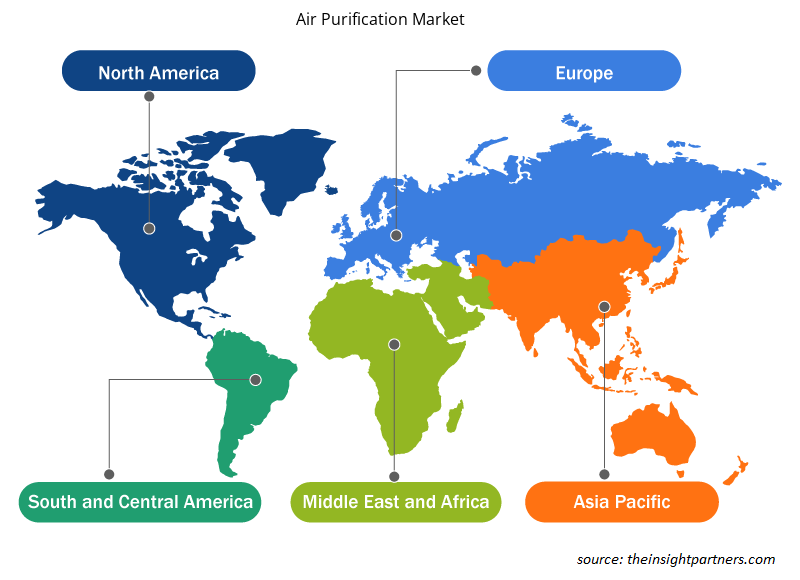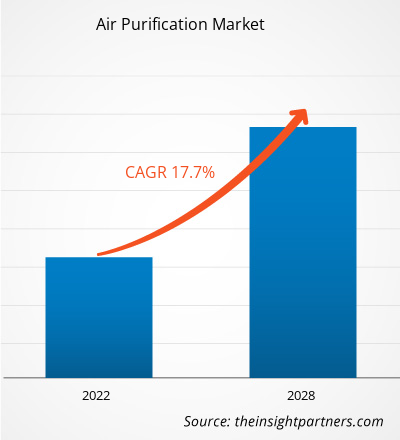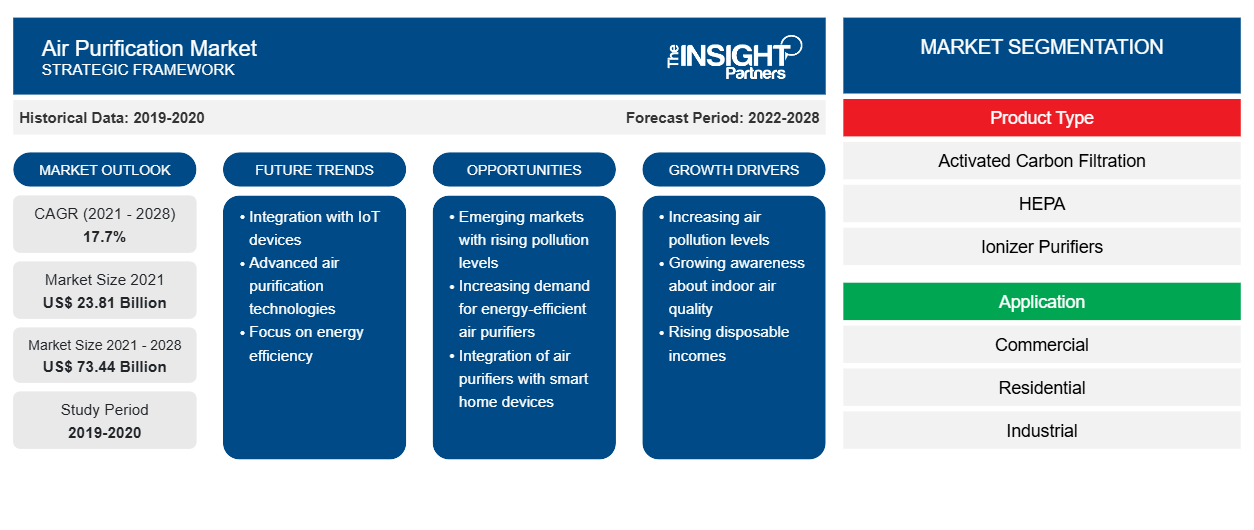Si prevede che il mercato della purificazione dell'aria crescerà da 23.809,52 milioni di dollari nel 2021 a 73.437,36 milioni di dollari entro il 2028. Si stima che crescerà a un CAGR del 17,7% dal 2021 al 2028.
L'aumento delle malattie trasmesse per via aerea dovuto all'aumento dell'inquinamento atmosferico è un fattore chiave attribuito alla crescita del mercato. Inoltre, la crescente consapevolezza tra i consumatori sull'uso dei purificatori d'aria, un aumento del reddito disponibile e un miglioramento dello standard di vita sono i fattori principali che stimolano la crescita del mercato. La crescente tendenza all'adozione di purificatori d'aria portatili e intelligenti sta ulteriormente spingendo le dinamiche di mercato nel periodo di previsione. Le iniziative governative di supporto relative agli standard sulle emissioni, all'applicazione delle normative sulla salute e sicurezza della forza lavoro e alla modifica delle attuali politiche sulla purezza dell'aria rafforzano ulteriormente le dinamiche di mercato per il mercato della purificazione dell'aria . Ad esempio, nell'agosto 2021, l'India aveva pianificato di ristabilire i nuovi standard nazionali sulla qualità dell'aria ambiente (NAAQS) nel 2022.
I nuovi standard includono componenti di particolato ultrafine, che scendono al di sotto del PM2.5 in presenza di più inquinanti. Inoltre, a settembre 2021, l'Organizzazione mondiale della sanità (OMS) ha introdotto nuove linee guida sulla qualità dell'aria globale (AQG) per proteggere la salute delle popolazioni riducendo i livelli di inquinanti atmosferici chiave che contribuiscono al cambiamento climatico. Pertanto, tali iniziative aumentano ulteriormente la necessità di prodotti per la purificazione dell'aria, guidando le prospettive di mercato nel periodo di previsione.
La domanda globale di filtri dell'aria portatili è una tendenza chiave che sta proliferando il mercato. Il cambiamento dello stile di vita ha un impatto diretto sulla salute delle persone, aumentando la necessità di prodotti per la purificazione dell'aria. I purificatori d'aria portatili impiegano un filtro HEPA-13, un filtro al carbone e un rivestimento antimicrobico su tali filtri per prevenire la crescita batterica. Questi filtri sono piuttosto efficaci e di tendenza in termini di adozione. Il crescente livello di inquinamento e un numero crescente di malattie trasmesse per via aerea hanno accelerato la domanda di filtri dell'aria portatili. Lo studio dei ricercatori della Simon Fraser University rileva che avere un purificatore d'aria portatile in casa può ridurre gli impatti negativi dell'inquinamento atmosferico sullo sviluppo del cervello nei bambini. Gli investimenti in corso nei filtri dell'aria portatili stanno aiutando il mercato a prosperare.
Lo studio di mercato sulla purificazione dell'aria si concentra principalmente su due segmenti, ovvero tipo di prodotto e applicazione. Il segmento del tipo di prodotto è ulteriormente suddiviso in Filtrazione a carbone attivo, Aria particolata ad alta efficienza (HEPA), Purificatori ionizzatori, Irradiazione germicida ultravioletta (UVGI) e altri. Il segmento dell'applicazione è ulteriormente suddiviso in commerciale, residenziale e industriale. In base alla geografia, il mercato è suddiviso in Nord America, Europa, Asia Pacifico, Medio Oriente e Africa e Sud America.HEPA), Ionizer Purifiers, Ultraviolet Germicidal Irradiation (UVGI), and others. The application segment is further segmented into commercial, residential, and industrial. By geography, the market is segmented into North America, Europe, Asia Pacific, Middle East & Africa, and South America.
Personalizza questo report in base alle tue esigenze
Riceverai la personalizzazione gratuita di qualsiasi report, comprese parti di questo report, o analisi a livello nazionale, pacchetto dati Excel, oltre a usufruire di grandi offerte e sconti per start-up e università
-
Scopri le principali tendenze di mercato in questo rapporto.Questo campione GRATUITO includerà analisi di dati che spaziano dalle tendenze di mercato alle stime e alle previsioni.
Impatto della pandemia di COVID-19 sul mercato della purificazione dell'aria
Danimarca, Polonia e Francia sono tra i paesi con alti livelli di inquinamento atmosferico. L'ambiente è positivamente influenzato dalle normative governative in vari paesi europei in merito allo sviluppo di edifici ecosostenibili nei settori residenziale e commerciale. La regione è un importante centro manifatturiero e industriale per i settori delle attrezzature industriali, automobilistico, edile, energetico e dell'energia. Tuttavia, a causa dei blocchi aziendali, dei divieti di viaggio e delle interruzioni della catena di fornitura nel 2020, alcune di queste industrie sono diminuite nella regione, riducendo significativamente l'inquinamento atmosferico. Tuttavia, le crescenti preoccupazioni sulla sicurezza del SARS-CoV-2 hanno aumentato la domanda di purificazioni dell'aria.
I lockdown imposti dal governo hanno tenuto le persone in casa nel 2020, aumentando le vendite di purificatori d'aria residenziali. Vari produttori internazionali di purificatori d'aria vedono la pandemia come un'opportunità. Ad esempio, il gigante sudcoreano della purificazione dell'aria, Coway, si è espanso in Europa a causa della crescente domanda di purificatori d'aria nella regione. L'azienda ha rilevato il team di integrazione da Serviceplan e l'unità dall'agenzia Plan.Net. Pertanto, l'aumento dell'inquinamento atmosferico e l'inquinamento causato da virus e batteri offrono opportunità di crescita per gli operatori del mercato europeo della purificazione dell'aria.
Approfondimenti di mercato - Mercato della purificazione dell'aria
L'aumento dell'urbanizzazione e dell'industrializzazione sta spingendo la crescita del mercato
L'aumento dell'urbanizzazione aumenterebbe necessariamente la necessità di prodotti per filtri dell'aria su larga scala in applicazioni residenziali e commerciali, il che aiuterebbe a guidare la crescita del mercato nel periodo di previsione. I paesi nelle economie in via di sviluppo stanno prevalentemente sperimentando l'aumento dell'urbanizzazione a un ritmo più rapido. L'aumento della popolazione sta anche aiutando le persone a spostarsi verso l'urbanizzazione, aiutando il mercato a crescere. Secondo il Gruppo della Banca Mondiale, la popolazione urbana mondiale aumenterà di 1,5 volte fino a 6 miliardi nel 2045. Inoltre, secondo il World Economic Forum, si prevede che la popolazione mondiale nelle città aumenterà dal 55% nel 2022 all'80% entro il 2050. I paesi dell'Asia Pacifica hanno opportunità senza precedenti per catalizzare lo sviluppo economico attraverso una maggiore urbanizzazione nei prossimi anni. Il crescente reddito e la capacità di spesa delle persone nelle economie in via di sviluppo e la crescente domanda in vari settori di utilizzo finale come automobilistico, sanitario e medico, edilizia e costruzioni, manifatturiero ed energia e servizi di pubblica utilità sono i principali fattori che guidano la crescita del mercato della purificazione dell'aria. L'aumento dell'urbanizzazione include l'espansione di scuole, college, ospedali, complessi commerciali, case residenziali e altri fattori, in cui emerge la necessità di aria pulita, che aiuta a guidare il mercato. L'aumento dell'urbanizzazione ha portato a un enorme inquinamento dell'aria interna ed esterna, che sta ulteriormente aumentando la domanda di purificatori d'aria
Informazioni basate sul tipo di prodotto
In base al tipo di prodotto, il mercato della purificazione dell'aria è segmentato in filtrazione a carbone attivo, aria particolata ad alta efficienza (HEPA), purificatori ionizzatori, irradiazione germicida ultravioletta (UVGI) e altri. Il segmento HEPA ha rappresentato la quota di mercato maggiore nel 2021 a causa della crescente domanda da parte di vari settori, tra cui semiconduttori e microelettronica.
Approfondimenti basati sulle applicazioni
In base all'applicazione, il mercato della purificazione dell'aria è segmentato in commerciale, residenziale e industriale. Il segmento commerciale ha rappresentato la quota di mercato maggiore nel 2021.
Approfondimenti regionali sul mercato della purificazione dell'aria
Le tendenze regionali e i fattori che influenzano il mercato della purificazione dell'aria durante il periodo di previsione sono stati ampiamente spiegati dagli analisti di Insight Partners. Questa sezione discute anche i segmenti e la geografia del mercato della purificazione dell'aria in Nord America, Europa, Asia Pacifico, Medio Oriente e Africa e Sud e Centro America.

- Ottieni i dati specifici regionali per il mercato della purificazione dell'aria
Ambito del rapporto di mercato sulla purificazione dell'aria
| Attributo del report | Dettagli |
|---|---|
| Dimensioni del mercato nel 2021 | 23,81 miliardi di dollari USA |
| Dimensioni del mercato entro il 2028 | 73,44 miliardi di dollari USA |
| CAGR globale (2021 - 2028) | 17,7% |
| Dati storici | 2019-2020 |
| Periodo di previsione | 2022-2028 |
| Segmenti coperti |
Per tipo di prodotto
|
| Regioni e Paesi coperti |
America del Nord
|
| Leader di mercato e profili aziendali chiave |
|
Densità degli attori del mercato della purificazione dell'aria: comprendere il suo impatto sulle dinamiche aziendali
Il mercato della purificazione dell'aria sta crescendo rapidamente, spinto dalla crescente domanda degli utenti finali dovuta a fattori quali l'evoluzione delle preferenze dei consumatori, i progressi tecnologici e una maggiore consapevolezza dei benefici del prodotto. Con l'aumento della domanda, le aziende stanno ampliando le loro offerte, innovando per soddisfare le esigenze dei consumatori e capitalizzando sulle tendenze emergenti, il che alimenta ulteriormente la crescita del mercato.
La densità degli operatori di mercato si riferisce alla distribuzione di aziende o società che operano in un particolare mercato o settore. Indica quanti concorrenti (operatori di mercato) sono presenti in un dato spazio di mercato in relazione alle sue dimensioni o al valore di mercato totale.
Le principali aziende che operano nel mercato della purificazione dell'aria sono:
- La società Whirlpool
- Camfil
- DAIKIN INDUSTRIES, Ltd.
- Honeywell International Inc.
- Koninklijke Philips NV
Disclaimer : le aziende elencate sopra non sono classificate secondo un ordine particolare.

- Ottieni una panoramica dei principali attori del mercato della purificazione dell'aria
Gli operatori che operano nel mercato della purificazione dell'aria si concentrano principalmente sullo sviluppo di prodotti avanzati ed efficienti.
- A novembre 2019, Philips India, una sussidiaria di Royal Philips, ha lanciato la serie air purifiers-800 sul mercato indiano. Ciò ha portato Philips a fornire purificatori d'aria in diversi segmenti di prezzo.
- A maggio 2021, Daikin ha lanciato Air Purifiers, purificatori d'aria portatili per ambienti progettati per migliorare la qualità dell'aria interna per il Medio Oriente e l'Africa. L'azienda ha introdotto due modelli, ovvero i modelli premium ed economy.
Elenco delle aziende
- TECNOLOGIE ATTIVEPURE LLC
- Società WHIRLPOOL
- CAMFIL
- DAIKIN INDUSTRIES, LTD.
- HONEYWELL INTERNATIONAL, INC.
- IQAIR NORTH AMERICA, INC.
- CONIUGE PHILIPS NV
- LG ELETTRONICA, INC.
- SOCIETÀ PANASONIC
- Società anonima UNILEVER.
- Analisi storica (2 anni), anno base, previsione (7 anni) con CAGR
- Analisi PEST e SWOT
- Valore/volume delle dimensioni del mercato - Globale, Regionale, Nazionale
- Industria e panorama competitivo
- Set di dati Excel
Report recenti
Testimonianze
Motivo dell'acquisto
- Processo decisionale informato
- Comprensione delle dinamiche di mercato
- Analisi competitiva
- Analisi dei clienti
- Previsioni di mercato
- Mitigazione del rischio
- Pianificazione strategica
- Giustificazione degli investimenti
- Identificazione dei mercati emergenti
- Miglioramento delle strategie di marketing
- Aumento dell'efficienza operativa
- Allineamento alle tendenze normative























 Ottieni un campione gratuito per - Mercato della purificazione dell'aria
Ottieni un campione gratuito per - Mercato della purificazione dell'aria